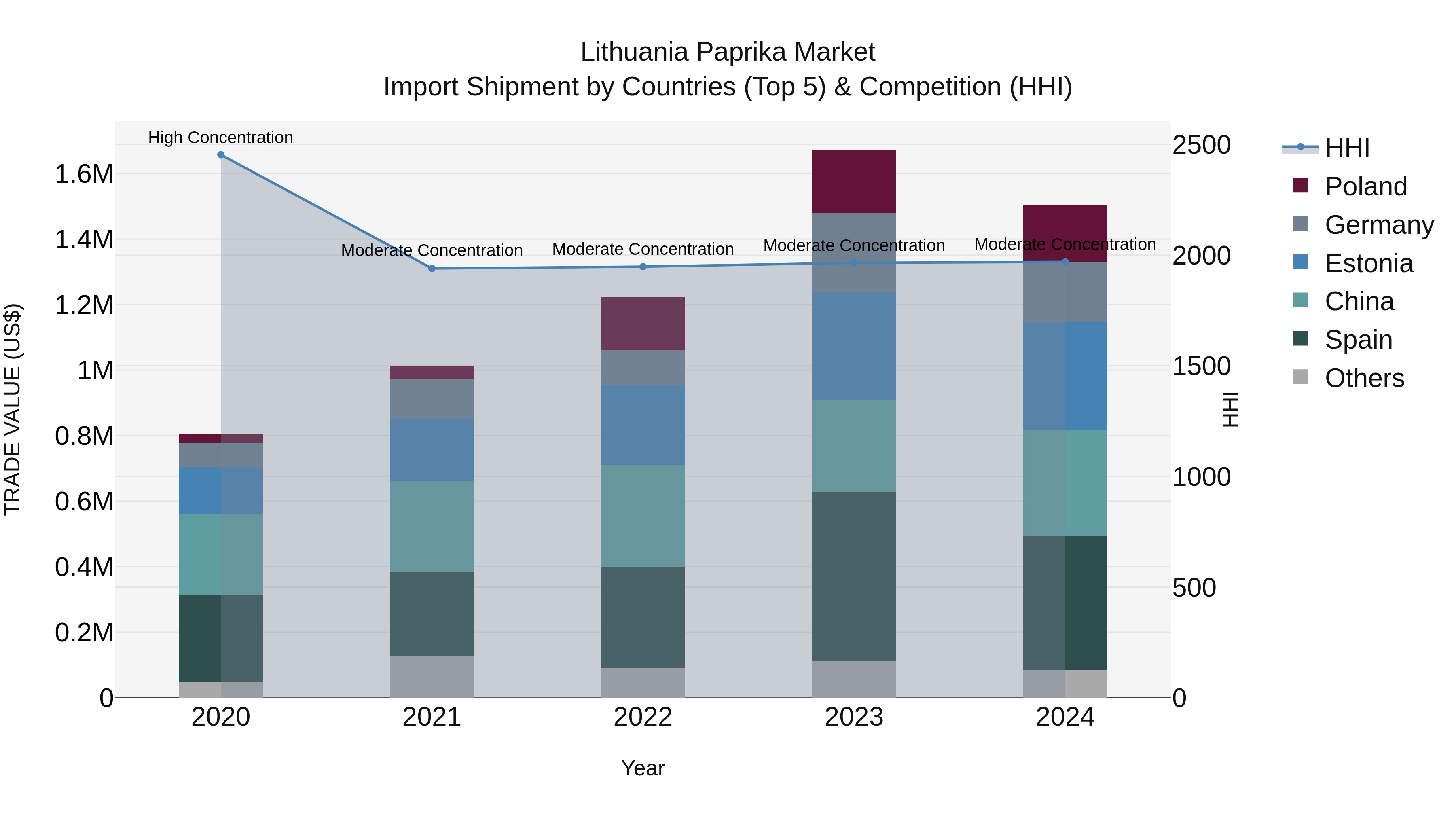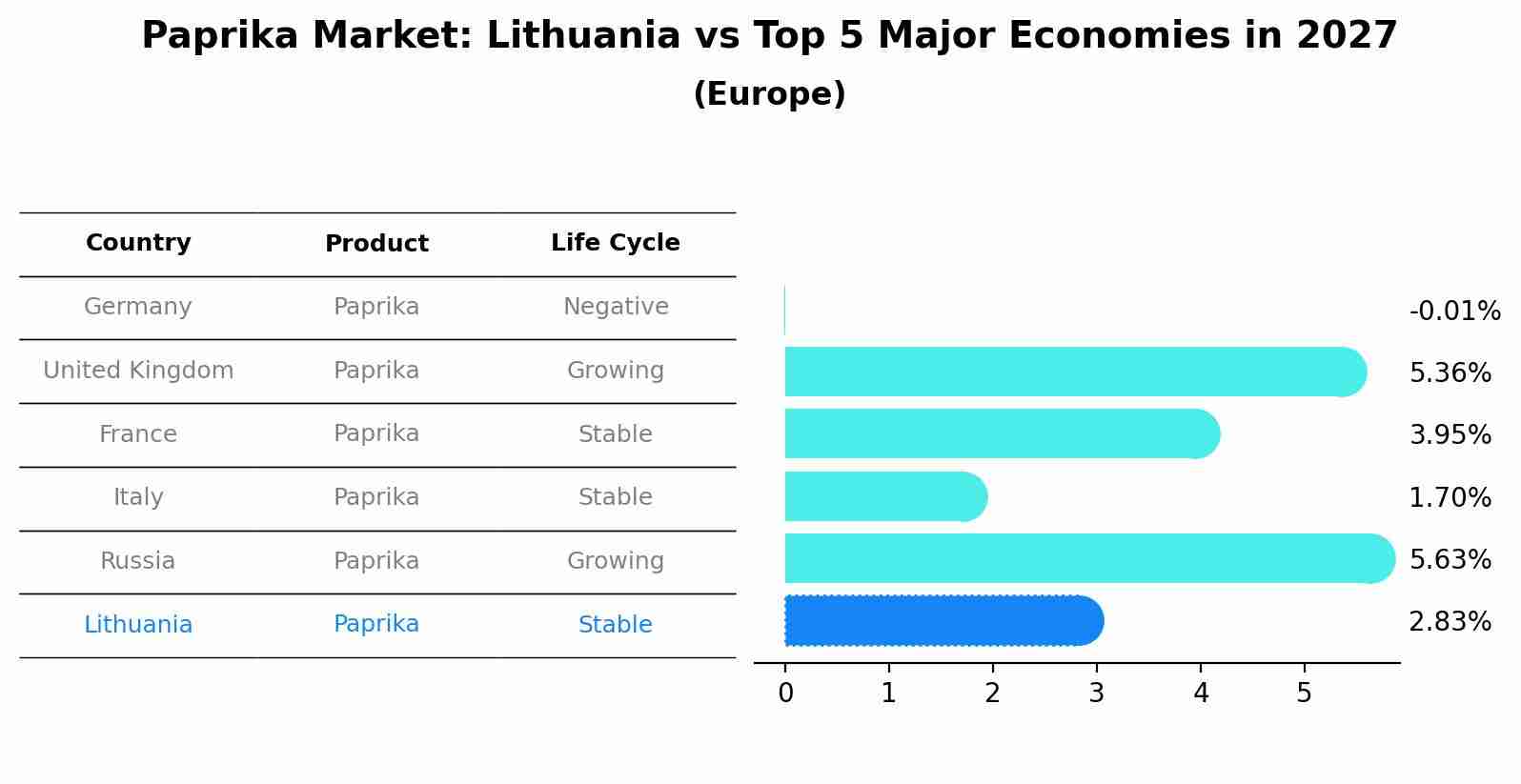Lithuania Paprika Market (2025-2031) | Companies, Share, Segmentation, Revenue, Value, Size, Trends, Growth, Forecast, Analysis, Industry & Outlook
| Product Code: ETC4842589 | Publication Date: Nov 2023 | Updated Date: Nov 2025 | Product Type: Market Research Report | |
| Publisher: 6Wresearch | Author: Shubham Padhi | No. of Pages: 60 | No. of Figures: 30 | No. of Tables: 5 |
Lithuania Paprika Market Top 5 Importing Countries and Market Competition (HHI) Analysis
In 2024, Lithuania saw a steady flow of paprika imports, with top suppliers including Spain, Estonia, China, Germany, and Poland. Despite the moderate concentration indicated by the Herfindahl-Hirschman Index (HHI), the market experienced a robust compound annual growth rate (CAGR) of 16.94% from 2020 to 2024. However, there was a slight decline in growth rate from 2023 to 2024 at -9.92%. This data suggests a dynamic market for paprika imports in Lithuania, with key players maintaining their presence while possibly facing some challenges in the immediate term.

Paprika Market: Lithuania vs Top 5 Major Economies in 2027 (Europe)
In the Europe region, the Paprika market in Lithuania is projected to expand at a stable growth rate of 2.83% by 2027. The largest economy is Germany, followed by United Kingdom, France, Italy and Russia.

Key Highlights of the Report:
- Lithuania Paprika Market Outlook
- Market Size of Lithuania Paprika Market, 2024
- Forecast of Lithuania Paprika Market, 2031
- Historical Data and Forecast of Lithuania Paprika Revenues & Volume for the Period 2021-2031
- Lithuania Paprika Market Trend Evolution
- Lithuania Paprika Market Drivers and Challenges
- Lithuania Paprika Price Trends
- Lithuania Paprika Porter`s Five Forces
- Lithuania Paprika Industry Life Cycle
- Historical Data and Forecast of Lithuania Paprika Market Revenues & Volume By Product for the Period 2021-2031
- Historical Data and Forecast of Lithuania Paprika Market Revenues & Volume By Vegetable for the Period 2021-2031
- Historical Data and Forecast of Lithuania Paprika Market Revenues & Volume By Spice Powder for the Period 2021-2031
- Historical Data and Forecast of Lithuania Paprika Market Revenues & Volume By Paprika Oleoresin for the Period 2021-2031
- Historical Data and Forecast of Lithuania Paprika Market Revenues & Volume By Others for the Period 2021-2031
- Historical Data and Forecast of Lithuania Paprika Market Revenues & Volume By Application for the Period 2021-2031
- Historical Data and Forecast of Lithuania Paprika Market Revenues & Volume By Food for the Period 2021-2031
- Historical Data and Forecast of Lithuania Paprika Market Revenues & Volume By Pharmaceuticals for the Period 2021-2031
- Historical Data and Forecast of Lithuania Paprika Market Revenues & Volume By Cosmetics for the Period 2021-2031
- Historical Data and Forecast of Lithuania Paprika Market Revenues & Volume By Others for the Period 2021-2031
- Lithuania Paprika Import Export Trade Statistics
- Market Opportunity Assessment By Product
- Market Opportunity Assessment By Application
- Lithuania Paprika Top Companies Market Share
- Lithuania Paprika Competitive Benchmarking By Technical and Operational Parameters
- Lithuania Paprika Company Profiles
- Lithuania Paprika Key Strategic Recommendations
Frequently Asked Questions About the Market Study (FAQs):
1 Executive Summary |
2 Introduction |
2.1 Key Highlights of the Report |
2.2 Report Description |
2.3 Market Scope & Segmentation |
2.4 Research Methodology |
2.5 Assumptions |
3 Lithuania Paprika Market Overview |
3.1 Lithuania Country Macro Economic Indicators |
3.2 Lithuania Paprika Market Revenues & Volume, 2021 & 2031F |
3.3 Lithuania Paprika Market - Industry Life Cycle |
3.4 Lithuania Paprika Market - Porter's Five Forces |
3.5 Lithuania Paprika Market Revenues & Volume Share, By Product, 2021 & 2031F |
3.6 Lithuania Paprika Market Revenues & Volume Share, By Application, 2021 & 2031F |
4 Lithuania Paprika Market Dynamics |
4.1 Impact Analysis |
4.2 Market Drivers |
4.2.1 Increasing consumer awareness about the health benefits of paprika |
4.2.2 Growing demand for natural and organic food products |
4.2.3 Rising popularity of ethnic cuisines using paprika as a key ingredient |
4.3 Market Restraints |
4.3.1 Fluctuating prices of raw materials used in paprika cultivation |
4.3.2 Seasonal variations impacting the availability and quality of paprika |
4.3.3 Competition from substitute products like chili powder and other spices |
5 Lithuania Paprika Market Trends |
6 Lithuania Paprika Market Segmentations |
6.1 Lithuania Paprika Market, By Product |
6.1.1 Overview and Analysis | 6.1.3 Lithuania Paprika Market Revenues & Volume, By Vegetable, 2021-2031F |
6.1.3 Lithuania Paprika Market Revenues & Volume, By Spice Powder, 2021-2031F |
6.1.4 Lithuania Paprika Market Revenues & Volume, By Paprika Oleoresin, 2021-2031F |
6.1.5 Lithuania Paprika Market Revenues & Volume, By Others, 2021-2031F |
6.2 Lithuania Paprika Market, By Application |
6.2.1 Overview and Analysis |
6.2.2 Lithuania Paprika Market Revenues & Volume, By Food, 2021-2031F |
6.2.3 Lithuania Paprika Market Revenues & Volume, By Pharmaceuticals, 2021-2031F |
6.2.4 Lithuania Paprika Market Revenues & Volume, By Cosmetics, 2021-2031F |
6.2.5 Lithuania Paprika Market Revenues & Volume, By Others, 2021-2031F |
7 Lithuania Paprika Market Import-Export Trade Statistics |
7.1 Lithuania Paprika Market Export to Major Countries |
7.2 Lithuania Paprika Market Imports from Major Countries |
8 Lithuania Paprika Market Key Performance Indicators |
8.1 Average selling price of paprika products |
8.2 Number of new product launches and innovations in the paprika market |
8.3 Consumer sentiment and engagement with paprika-related content on social media |
8.4 Percentage of households regularly purchasing paprika products |
8.5 Growth in the number of paprika cultivation farms in Lithuania |
9 Lithuania Paprika Market - Opportunity Assessment |
9.1 Lithuania Paprika Market Opportunity Assessment, By Product, 2021 & 2031F |
9.2 Lithuania Paprika Market Opportunity Assessment, By Application, 2021 & 2031F |
10 Lithuania Paprika Market - Competitive Landscape |
10.1 Lithuania Paprika Market Revenue Share, By Companies, 2024 |
10.2 Lithuania Paprika Market Competitive Benchmarking, By Operating and Technical Parameters |
11 Company Profiles |
12 Recommendations | 13 Disclaimer |
- Single User License$ 1,995
- Department License$ 2,400
- Site License$ 3,120
- Global License$ 3,795
Search
Thought Leadership and Analyst Meet
Our Clients
Related Reports
- Afghanistan Apparel Market (2026-2032) | Growth, Outlook, Industry, Segmentation, Forecast, Size, Companies, Trends, Value, Share, Analysis & Revenue
- Canada Oil and Gas Market (2026-2032) | Share, Segmentation, Value, Industry, Trends, Forecast, Analysis, Size & Revenue, Growth, Competitive Landscape, Outlook, Companies
- Germany Breakfast Food Market (2026-2032) | Industry, Share, Growth, Size, Companies, Value, Analysis, Revenue, Trends, Forecast & Outlook
- Australia Briquette Market (2025-2031) | Growth, Size, Revenue, Forecast, Analysis, Trends, Value, Share, Industry & Companies
- Vietnam System Integrator Market (2025-2031) | Size, Companies, Analysis, Industry, Value, Forecast, Growth, Trends, Revenue & Share
- ASEAN and Thailand Brain Health Supplements Market (2025-2031) | Strategy, Consumer Insights, Analysis, Investment Trends, Opportunities, Growth, Size, Share, Industry, Revenue, Segments, Value, Segmentation, Supply, Forecast, Restraints, Outlook, Competition, Drivers, Trends, Demand, Pricing Analysis, Competitive, Strategic Insights, Companies, Challenges
- ASEAN Bearings Market (2025-2031) | Strategy, Consumer Insights, Analysis, Investment Trends, Opportunities, Growth, Size, Share, Industry, Revenue, Segments, Value, Segmentation, Supply, Forecast, Restraints, Outlook, Competition, Drivers, Trends, Demand, Pricing Analysis, Competitive, Strategic Insights, Companies, Challenges
- Europe Flooring Market (2025-2031) | Outlook, Share, Industry, Trends, Forecast, Companies, Revenue, Size, Analysis, Growth & Value
- Saudi Arabia Manlift Market (2025-2031) | Outlook, Size, Growth, Trends, Companies, Industry, Revenue, Value, Share, Forecast & Analysis
- Uganda Excavator, Crane, and Wheel Loaders Market (2025-2031) | Strategy, Consumer Insights, Analysis, Investment Trends, Opportunities, Growth, Size, Share, Industry, Revenue, Segments, Value, Segmentation, Supply, Forecast, Restraints, Outlook, Competition, Drivers, Trends, Demand, Pricing Analysis, Competitive, Strategic Insights, Companies, Challenges
Industry Events and Analyst Meet
Whitepaper
- Middle East & Africa Commercial Security Market Click here to view more.
- Middle East & Africa Fire Safety Systems & Equipment Market Click here to view more.
- GCC Drone Market Click here to view more.
- Middle East Lighting Fixture Market Click here to view more.
- GCC Physical & Perimeter Security Market Click here to view more.
6WResearch In News
- Doha a strategic location for EV manufacturing hub: IPA Qatar
- Demand for luxury TVs surging in the GCC, says Samsung
- Empowering Growth: The Thriving Journey of Bangladesh’s Cable Industry
- Demand for luxury TVs surging in the GCC, says Samsung
- Video call with a traditional healer? Once unthinkable, it’s now common in South Africa
- Intelligent Buildings To Smooth GCC’s Path To Net Zero


















